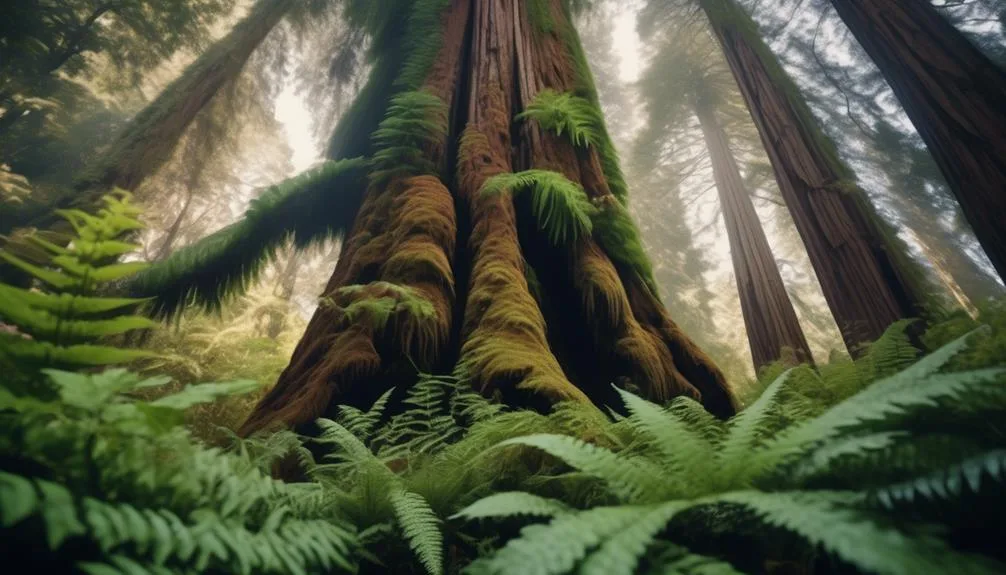Standing under a tall redwood tree evokes a sense of awe and peace. But what grows beneath these majestic giants?
The plants that thrive under them create a vital ecosystem, essential for the redwood forest's health and beauty.
From ground covers to shrubs, each plant has a unique relationship with the redwood, contributing to a visually stunning and ecologically important landscape.
Which plants are the best companions for redwood trees, and how do they support this remarkable environment's diversity and sustainability?
Shade-Tolerant Ground Covers
When planting shade-tolerant ground covers under redwood trees, it's essential to select varieties that thrive in low light conditions and can compete with the tree roots for nutrients and moisture.
Consider perennial vines for erosion control, as they not only offer beautiful foliage but also help stabilize the soil, preventing erosion on the sloped ground beneath redwood canopies.
Additionally, incorporating fungi partnerships for soil health can greatly benefit the overall ecosystem. Certain fungi form symbiotic relationships with plants, aiding in nutrient absorption and water retention, which is particularly beneficial when growing under redwoods where competition for resources is high.
Imagine the dappled light filtering through the towering redwood branches, illuminating the lush greenery of shade-tolerant ground covers, creating a serene and visually appealing understory beneath these majestic trees.
Native Wildflowers for Understory
Enhance the enchanting beauty of the redwood understory by introducing a vibrant tapestry of native wildflowers, adding a splash of color and diversity to the shaded forest floor.
Native wildflowers not only bring visual appeal but also play a crucial role in supporting the ecosystem. By planting pollinator-attracting flowers like Western columbine and California poppy, you can create a haven for bees, butterflies, and hummingbirds, contributing to the overall health of the redwood forest.
Additionally, these native wildflowers aid in soil enrichment, forming a harmonious relationship with the redwoods. Species such as trillium and bleeding heart help improve soil structure and provide essential nutrients.
Embracing a variety of native wildflowers in the redwood understory not only adds charm but also nurtures a thriving and balanced natural environment.
Drought-Tolerant Shrubs and Grasses
To further enrich the redwood understory, consider incorporating drought-tolerant shrubs and grasses that not only complement the native wildflowers but also thrive in the shaded environment, adding texture and resilience to the forest floor. When selecting companion plants for redwood trees, prioritize water wise landscaping and low maintenance gardening to ensure the overall health and sustainability of the ecosystem.
Here are some excellent choices to enhance the understory:
- Pacific Coast Iris: These stunning irises are both drought-tolerant and visually striking, adding a pop of color to the shaded areas.
- Creeping Oregon Grape: This low-maintenance shrub offers year-round interest with its glossy, holly-like leaves and vibrant yellow flowers.
- Deer Grass: With its graceful, arching blades, this ornamental grass brings a sense of movement and elegance to the understory.
- Yerba Buena: This aromatic ground cover not only thrives in dry conditions but also releases a refreshing minty fragrance when crushed.
Ferns and Mosses for Moisture Retention
Consider incorporating a variety of lush ferns and mosses to create a moisture-retaining layer that enhances the natural beauty and health of the redwood understory. These plants not only contribute to the aesthetic appeal but also offer several benefits for redwood tree health.
Ferns and mosses are excellent at retaining moisture, creating a microclimate that mimics the natural conditions of the redwood forest floor. They help regulate soil temperature and prevent excessive evaporation, ensuring the redwood trees have a consistent moisture supply.
To maintain optimal moisture levels in your redwood tree landscape, plant a diverse range of ferns and mosses, including sword ferns, maidenhair ferns, and feather mosses. Additionally, regularly mulch the area with fallen leaves and organic matter to further support moisture retention.
Deer-Resistant Plants for Redwood Forests
Amidst the lush ferns and mosses that create a moisture-retaining layer for your redwood tree landscape, it's important to select deer-resistant plants that will thrive in this environment and complement the grandeur of the redwood forest.
When choosing companion plants for your redwood trees, consider these deer-resistant options:
- Lavender: Not only does it repel deer, but its fragrant blooms also attract pollinators, making it a delightful addition to your redwood forest.
- Rosemary: This aromatic herb is a natural pest control and thrives in the dappled shade of the redwood canopy.
- Salvia: With its vibrant blooms and deer-resistant properties, salvia adds a pop of color while supporting local pollinators.
- Yarrow: This hardy, deer-resistant perennial provides a beautiful contrast to the towering redwoods and attracts beneficial insects for natural pest control.
Conclusion
Enhance your redwood forest with a thoughtful selection of companion plants. From shade-tolerant ground covers to drought-tolerant shrubs, each addition contributes to a thriving, diverse ecosystem.
How will your garden evolve with these carefully chosen companions?
Happy planting and nurturing your redwood trees!
Mark Hoffman is a dedicated arborist and tree care specialist with over a decade of experience. His love for trees began when he visited Yosemite National Park as a teenager and was awestruck by the giant sequoias. Mark pursued his passion by studying forestry at Michigan Technological University, where he earned a Bachelor of Science degree.
Since then, he has worked tirelessly in the field of arboriculture, helping to preserve and protect trees in his community. His expertise and dedication have made him a respected leader in the industry and a valuable resource for anyone seeking advice on tree care.
